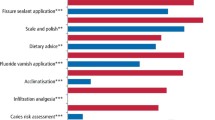Abstract
Looked after children (LAC) are children and young people (CYP) who have been under the continuous care of the local authority for more than 24 hours. Reasons for becoming looked after include concerns about abuse or neglect, breakdown in family functioning, or absence of a suitable caregiver (for example bereavement, parental illness, or separation, such as for unaccompanied asylum-seeking children). Many LAC live with foster families, extended family, or in residential care homes, but a CYP can be legally 'looked after' and still be living with their original or birth family, or living independently with support. Regardless of the circumstances, the local authority has responsibility for meeting the needs of the CYP, including dental care, usually via a named social worker.
The evidence available suggests that LAC are at higher risk of dental caries and pain. In 2021, Public Health England reported on inequalities in oral health in England and although evidence was limited, found LAC to have poorer oral health and access to care. It is important that LAC are considered for enhanced prevention and reviewed regularly to enable appropriate provision of dental care. Understanding who can consent for dental treatment is essential.
Key points
-
Looked after children (LAC) are commonly seen by the dental team - this paper provides a detailed understanding of who LAC are.
-
Circumstances where children have involvement with social care but are not LAC, including children on a child in need plan and children on a child protection plan, are also discussed.
-
The paper addresses specific issues of consent for LAC and includes a flowchart as a working tool to determine who has consent in a variety of circumstances.
This is a preview of subscription content, access via your institution
Access options
Subscribe to this journal
Receive 24 print issues and online access
$259.00 per year
only $10.79 per issue
Buy this article
- Purchase on Springer Link
- Instant access to full article PDF
Prices may be subject to local taxes which are calculated during checkout



Similar content being viewed by others
References
UK Government. Children Act 1989. 1989. Available at https://www.legislation.gov.uk/ukpga/1989/41/part/I (accessed November 2021).
National Society for the Prevention of Cruelty to Children. Statistics briefing: looked after children. 2021. Available at https://learning.nspcc.org.uk/media/1622/statistics-briefing-looked-after-children.pdf (accessed October 2021).
Hawkey N. Looked-after children and introducing a WNB pathway to support their care. BDJ In Pract 2020; 33: 29.
UK Government. The Care Planning, Placement and Case Review (England) Regulations 2010. 2010. Available at https://www.legislation.gov.uk/uksi/2010/959/contents (accessed October 2021).
UK Government. IRO Handbook: Statutory guidance for independent reviewing officers and local authorities on their functions in relation to case management and review for looked after children. 2010. Available at https://assets.publishing.service.gov.uk/government/uploads/system/uploads/attachment_data/file/337568/iro_statutory_guidance_iros_and_las_march_2010_tagged.pdf (accessed October 2021).
UK Government. Promoting the health and well-being of looked after children. Statutory guidance for local authorities, clinical commissioning groups and NHS England. 2015. Available at https://assets.publishing.service.gov.uk/government/uploads/system/uploads/attachment_data/file/1100188/Promoting_the_health_and_well-being_of_looked-after_children_August_2022_update.pdf (accessed October 2021).
Local Government Association. Healthy futures: Supporting and promoting the health needs of looked after children. 2016. Available at https://www.local.gov.uk/sites/default/files/documents/healthy-futures-supportin-9cf.pdf (accessed August 2021).
Sarri G, Evans P, Stansfeld S, Marcenes W. A school-based epidemiological study of dental neglect among adolescents in a deprived area of the UK. Br Dent J 2012; DOI: 10.1038/sj.bdj.2012.1042.
Keene E J, Skelton R, Day P F, Munyombwe T, Balmer R C. The dental health of children subject to a child protection plan. Int J Paediatr Dent 2015; 25: 428-435.
Williams A, Mackintosh J, Bateman B et al. The development of a designated dental pathway for looked after children. Br Dent J 2014; DOI: 10.1038/sj.bdj.2014.51.
Williams J, Jackson S, Maddocks A, Cheung W Y, Love A, Hutchings H. Case-control study of the health of those looked after by local authorities. Arch Dis Child 2001; 85: 280-285.
UK Government. Improving permanence for looked after children. 2013. Available at https://assets.publishing.service.gov.uk/government/uploads/system/uploads/attachment_data/file/264952/final_improving_permanence_data_pack_2013_sept.pdf (accessed October 2021).
UK Government. Outcomes for children looked after by local authorities in England. 2018. Available at https://assets.publishing.service.gov.uk/government/uploads/system/uploads/attachment_data/file/794535/Main_Text_Outcomes_for_CLA_by_LAs_2018.pdf (accessed October 2021).
UK Government. Delivering better oral health: an evidence-based toolkit for prevention. 2014. Available at https://www.gov.uk/government/publications/delivering-better-oral-health-an-evidence-based-toolkit-for-prevention (accessed August 2021).
Dental Defence Union. Consent and Young Patients. 2022. Available at https://www.theddu.com/guidance-and-advice/guides/dental-consent-and-young-patients (accessed November 2022).
United Nations Human Rights Office of the High Commissioner. Convention on the Rights of the Child. 1989. Available at https://www.ohchr.org/EN/ProfessionalInterest/Pages/CRC.aspx (accessed August 2021).
Future NHS. Who has Parental Responsibility? 2020. Available at https://future.nhs.uk/safeguarding/messageshowthread?threadid=8313:326 (accessed December 2021).
Kirby J, Harris J C. Development and evaluation of a 'was not brought' pathway: a team approach to managing children's missed dental appointments. Br Dent J 2019; 227: 291-297.
Author information
Authors and Affiliations
Contributions
Lucy Ridsdale and Richard Balmer had the original idea for the article. Lucy Ridsdale, Laura Johnston, Nadya James and Richard Balmer were all involved in writing the original draft and reviewing and editing. Nadya James produced the original document on which Figure 3 is based.
Corresponding author
Ethics declarations
The authors declare no conflicts of interest.
Rights and permissions
About this article
Cite this article
Ridsdale, L., Johnston, L., James, N. et al. Looked after children: an overview for the dental team. Br Dent J 234, 34–38 (2023). https://doi.org/10.1038/s41415-022-5359-3
Received:
Accepted:
Published:
Issue Date:
DOI: https://doi.org/10.1038/s41415-022-5359-3
This article is cited by
-
Dental core training in community dental services
British Dental Journal (2024)



